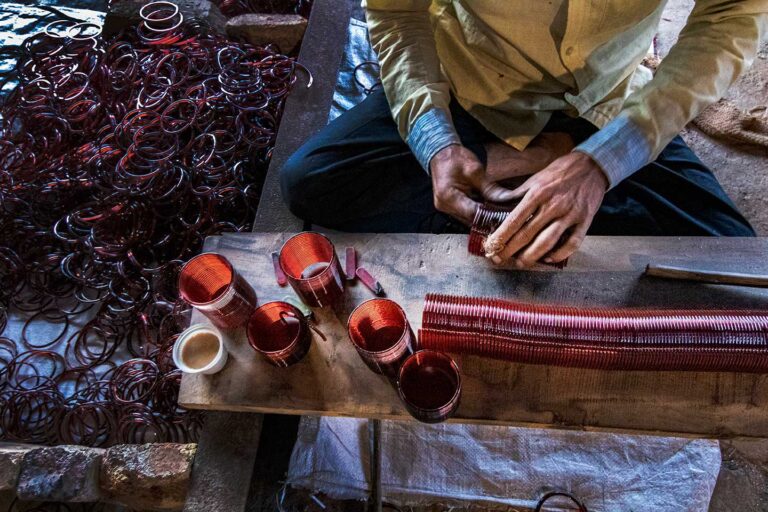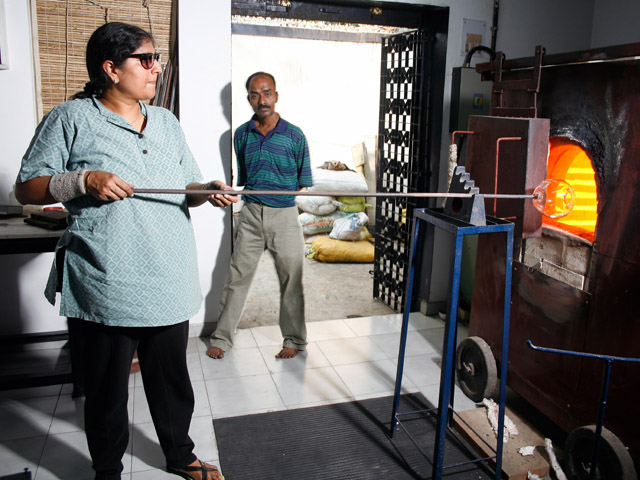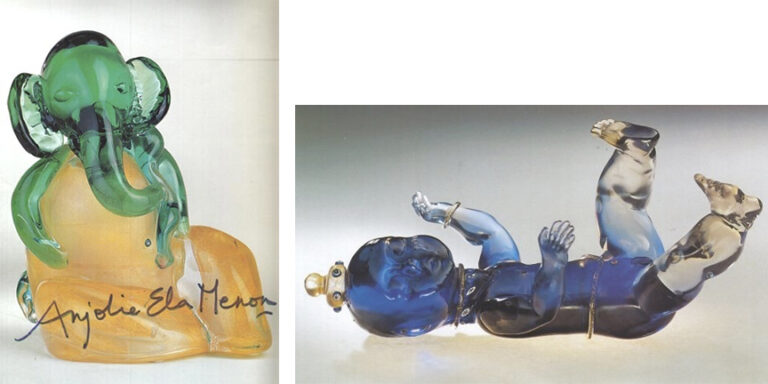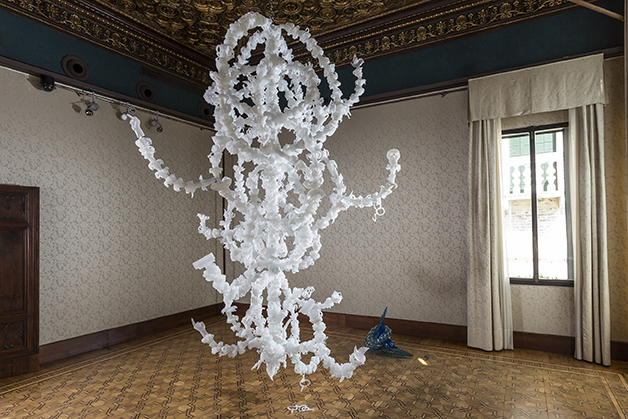Since the times of Mughal era, especially during the age of Emperor Akbar (who reigned from 1556 to 1605), Firozabad has been known as an ‘arena’ of the glass industry in India. It was during the Mughal era that the artform flourished as it brought artisans from Persia who migrated over to Firozabad and set up their shops due to the royal patronage. Soon the area became renowned for its glasswork, especially for producing the most beautiful intricate chandeliers. It also has a very rich glass-bangle industry that is an endemic craft trade across the Indian peninsula.
The production of glass began in antiquity, and glassmaking became a craft in the Middle Ages. This Uttar Pradesh town is now crafting intricate glass lamps that dazzle in homes in countries like Kuwait, Spain, Dubai, Australia, France, and the US. In current times it is known for producing sheet glass, optical glass, glass fiber, household glassware, glass containers, various glass items and materials, and the glass used in construction, illuminating engineering, and electrical engineering.
Firozabad was added as part of Taj Trapezium in 1996, which banned the use of coal/ coke in industries located there, for obvious ecological reasons. The introduction to Gas Pipeline from the Gas Authority of India Limited in the glass industries has indeed reduced its carbon consumption to a large extent. Glassware is the main industry in Firozabad, about 240 km from Taj city Agra, and almost 70 percent of the country’s small-scale glass production is concentrated in this district in Uttar Pradesh and its art and craft fairs.
Firozabad’s glassware makers have also got help from other areas, like the government and educational institutes like the National Institute of Design (NID) whose students have organized workshops with the town’s artisans in order to help them develop new and better designs in tune with the present demand. Additionally, it’s not just lamps and bangles that this glass city boasts of. Delicate perfume bottles, jars, tumblers, and decanters with intricate designs, glass jewellery, vases, and even flowers.
With the advent of better furnaces and technology, the quality of items created has vastly improved over the years. Some of it elevates into art. Take the case of a galaxy created by blown glass. Inspired by man’s exploration of space, and the various hues of celestial bodies, an artwork titled My Glass Galaxy, was showcased at the recent (2019) Serendipity Arts Festival in Goa. It brings alive the ethereal quality and mysteriousness of planets and stars through the medium of blown glass. Artist Srila Mookherjee, who learnt the art of glass blowing under Anthony Stern in London, has set up her studio in Kolkata. Using only indigenous material, she feels the vessel form is the epitome of beauty, and serves as an ideal vehicle for her ideas and creativity.
A similar message emanates from Antic, an installation in glass beads and metal by Manoj Pilli, Vineeta Oswal and Ishtiyak Ali. From the vastness of the universe to the smallest of living beings, blown glass does justice to it all. An artwork called Utopian World: Sentient Beings celebrates every living being’s existence on this planet. Dainty glass replicas of insects, reptiles, birds, plants, set dwellers, and more are a visual delight. The message by artists Swagata Naidu, Rajesh Sharma and Zafar Ahmed is one of equality, that even if man is superior to others, they all deserve the right to share all of nature’s resources equally, receiving and giving in equal measure. Only, the thought in today’s circumstances is utopian, with humans usurping most resources of the earth, leading to extinction of hundreds of species every-day.
On the other end of the spectrum, the glass painting traditions of India is one of the most refined art forms, which emerged in the state of Gujarat in the beginning of the 18th century. It is said that historically the Chinese artists who had settled in the region influenced the local traditions of producing glass paintings. Glass paintings of that era usually consisted of engraving laid down on the back of the glass and were painted from the reverse. The glass paintings were noted for their sheer brilliance, stunning clarity and use of rich colors.
According to historical documentation available, glass painting of that time is a form of art, which has evolved and gained prominence recently as well. Glass painting basically involves painting on tinted glass that astoundingly transforms a plain piece of glass, into a wonderful piece of art. To amplify the effect of painted glass one must place it in relation to proper lighting. Some glass paintings require back lighting while others require lighting from the top. The images are usually diverse and can range from religious to decorative, and the compositions are usually unique and individual in character though they may also be transpositions of existing compositions. After being outlined, the composition is painted, most times using special paints. The paintings are also embedded with semi-precious stones, beaten gold leaf or glitter that is used to decorate or enhance the look of the work.
Pre-dating the contemporary expressions, is the work by renowned Modern artist Anjolie Ela Menon who created sculptures with glass. Her collection of Murano glass from Italy, features sculptures of Lingams, Ganeshas and Balagopals received rave reviews in London, San Francisco, Mumbai and Delhi, when it premiered back in 2003. In her hands-on manner that she is well known for, Menon traveled to Murano, a small town near Venice. She worked with the craftsmen who are more commonly known as the Maestri of Murano and are considered the present-day custodians of the renowned Italian glass art. Here she collaborated with Antonio Da Ros, regarded as the most important artist of Murano glass. Menon would work in fiber-glass and the burly workmen would convert the artworks into molten ‘glass lava’, which in her words was ‘sensuous’ and magical. What emerged from these two and a half years of intense labor of love have been 80 works of art mostly symbolizing traditional forms of Indian Iconography.
Artist Hemi Bawa recently did a series of artworks, titled Bodies of Light at Artspeaks India, featuring the intricate jaalis of Mughal architecture and form that find an expression in her ‘screen printing’ on copper and glass. Her interesting ‘transformation’ of waste and broken glass from car windshields formed the foundation of her acclaimed ‘Torso series’. The artist, who works with a broad range of mediums — including paint, aluminum, bronze and cast glass —compartmentalizes her life’s experience working with glass, as “a tale of three cities”— Delhi, Kasauli and Goa. The ‘cities’ brought to the works their distinct geography and culture, the distinct flavors of each region are deeply enmeshed in Bawa’s creative journey and subsequently in her work.
Internationally contemporary artists like Ai Weiwei, Shaikha Al Mazrou, Monica Bonvicini, Amber Cowan, Tony Cragg, Monir Shahroudy Farmanfarmaian, Shahla Friberg, Michael Joo, Misha Kahn, Jim Lambie, Vik Muniz, Kohei Nawa, Hans Op de Beeck, Sung-Won Park, Jaume Plensa, Tristano di Robilant, Laura de Santillana, Judith Schaechter, Thaddeus Wolfe, and Dustin Yellin—have all used glass to address formal and aesthetic concerns that transcend the traditional uses of the medium.
Glass, quite like ceramic art, has the fragility factor but once it is put in place that glass artifacts have to be handled carefully, it has managed to transcend traditional uses that have been ascribed to it and over the years it has become a dynamic and contemporary medium.
Glass sculpture, painting and artifacts have the ability to bring that delicate beauty to an interior or exterior space and it is this factor that sets it in its own category of aesthetic objects. Whether it is an ethereal quality that one is looking for or one which speaks of a more robust and rugged nature glass has the ability to provide artist expression with the required range of expression.









